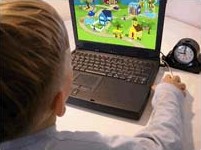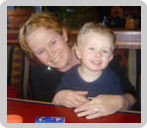TT-TTB
Scientific Basis
Research
Dr. Chris
Advisors
DOE Research
Teach Town Basics
Overview - Grounded in the science of autism researchWe are dedicated to using scientifically validated practices that incorporate the latest academic research in the development of our products. Our programs are based on existing interventions such as Applied Behavior Analysis (ABA) that have been proven effective in the treatment of autism and our intervention tools and training programs are being validated through ongoing rigorous research studies funded by the U.S. Department of Education.
Scientific Basis
Several studies have indicated the validity and efficacy of using Applied Behavior Analysis (ABA), cognitive-behavioral and developmental techniques for treating the symptoms of autism (McEachin, Smith, & Lovaas, 1993). Although some studies have demonstrated efficacy for specific computerized interventions (e.g. Bosseler & Massaro, 2003), no research to date has assessed the efficacy of using a computerized comprehensive treatment and no software-based program, to date, has provided naturalistic non-computer activities for generalization. It is important that the validity of this type of treatment be assessed, as computerized treatments for children with autism and related disorders are quickly becoming a popular trend with parents and schools. If computerized treatment programs are shown to be effective, this alternative to treatment could save parents and school districts millions of dollars on materials, staffing, and training. In addition, providing parents with simple, naturalistic, generalization activities is likely to result in more widespread change in the child than software alone. Finding quality intervention is often difficult. Offering a state-of-the-art computerized intervention would allow easier access to quality treatment for many families. Research supports the notion that having access to effective treatment may reduce parental stress levels (e.g. Hastings & Johnson, 2001). Having easy access to an effective treatment would likely reduce stress levels in parents of children with autism.
Using proven behavioral programs, psychologists have shown that they can often improve the quality of life for many children with autism and help them to integrate more successfully into society. More than 20 years of research and clinical data demonstrate that behavioral programs represent the single best treatment for millions of children (Sulzer-Azaroff & Mayer, 1991). This popular approach to treatment for children with autism is termed Applied Behavioral Analysis (ABA). ABA is a procedure that uses the principles of learning theory (i.e. reinforcement and shaping) to improve behaviors that are deemed socially significant. �ABA is objective and easily measurable. Research demonstrates that ABA interventions result in positive behavioral changes (Baer, Wolf & Risley, 1987).
In 1987, Ivar Lovaas published his results of the implementation of a type of ABA called Discrete Trial Training (DTT) using 38 children who received 40 hours per week of DTT. Following treatment, many of the children were able to attend regular education classrooms and most children demonstrated increases in IQ scores. DTT tasks are broken down into short simple pieces, or trials. Discrete Trial Training involves a series of distinct repeated lessons or trials taught one-to-one. Each trial consists of an antecedent, a directive or request for the individual to perform an action; a behavior, or response from the person; and a consequence, a reaction from the therapist based upon the response of the person. Positive reinforcers are selected by evaluating the individual's preferences. DTT is typically performed by a therapist in a one-on-one setting with the child. DTT has continued to be a popular choice of intervention for children with autism and although it has evolved since the 1987 Lovaas study, it continues to prove to be one of the most effective interventions available for children with autism. DTT has been used to successfully increase IQ, language, and cognitive skills and has also been shown to have long-term success (McEachin, Smith, & Lovaas, 1993).
It is important to note that the term ABA does not only apply to DTT as is often implied in the popular media. ABA includes a variety of approaches, many of which are more naturalistic than DTT, and which demonstrate more generalization of learned skills. One example is Pivotal Response Training (PRT), which is a naturalistic ABA intervention developed by Koegel, et al. (1989). Two pivotal behaviors were identified that appear to affect a wide range of behaviors in children with autism: motivation and responsivity to multiple cues. These behaviors are central to a wide area of functioning so positive changes in these behaviors can have widespread effects on other behaviors. PRT is able to increase the generalization of new skills and increases the motivation of children to perform the behaviors being taught. PRT works to increase motivation by including components such as child choice, turn-taking, reinforcing attempts and interspersing maintenance tasks. PRT has been used to target language skills, play skills and social behaviors in children with autism. Like DTT, PRT has been shown to be effective in a number of published research studies (e.g. Schreibman & Pierce, 1993). PRT and other naturalistic ABA approaches have been shown to be effective for increasing language (Koegel, Koegel, & McNerney, 2001), play (Stahmer, 1995), imitation (Ingersoll, Schreibman & Tran 2003), social skills (Pierce & Schreibman, 1995), and joint attention (Whalen & Schreibman, 2003). Although generalization is almost always shown in these studies, some of these studies have even shown collateral effects of treatment to untargeted behaviors (e.g. Pierce & Schreibman, 1995; Whalen, Schreibman, & Ingersoll, in press). Other naturalistic interventions such as developmental models (e.g. Floortime and Relationship Development Intervention (RDI)) have also been successful in remediating some of the symptoms of autism (e.g. Ingersoll, Dvortcsak, Whalen, and Sikora, in press).
Children with autism have frequently been shown to respond well to treatments that involve visual supports such as videos (e.g. Schreibman, Whalen, & Stahmer, 2000), pictures (e.g. Bryan & Gast, 2000), and computers (e.g. Bernard-Opitz, Sriram, & Nakhoda-Sapuan, 2001). Programs that emphasize visual support strategies are commonly used in classrooms for children with autism and similar disorders. For instance, the TEACCH program (developed in the 1970's by developmental psychologist Eric Schopler) (Schopler, et al., 1978) utilizes visual cues to increase independence and to teach new skills to children with autism. The Picture Exchange Communication System (PECS; Bondy 1998) also uses visual supports for communication for children with autism and other children with verbal difficulties. Social skills are often targeted using visual social stories and research shows that this approach is effective for children with autism (Lorimer, Simpson, Smith, & Ganz, 2002).
Recently, several studies have shown the efficacy of using computers to teach children with autism and these studies show promising outcomes (e.g. Moore, & Calvert, 2000). Bosseler and Massaro (2003) developed and assessed a computer-animated tutor to teach vocabulary and grammar to eight children with autism. Their program included receptive and expressive language activities. This program was successful in teaching language to all participants and generalization to the children's natural environment was reported. In another study, inappropriate verbalizations were decreased and functional communication was increased using a computerized intervention and these skills generalized to a classroom environment (Hetzroni & Tannuous, 2004). Computerized techniques were also utilized to teach social understanding to children with autism via computerized social stories (Bernard-Opitz, Sriram, & Nakhoda-Sapuan, 2001). Children with autism did better with computerized visual social stories than using traditional teaching techniques. These studies suggest that children with autism are able to learn skills on the computer efficiently and effectively and that these skills may generalize to the natural environment.
An optimal program for children with autism should include programs that target all of the associated deficits with the disorder. Nonverbal and verbal communication (i.e. language), play, imitation, social skills, behavior, and cognitive skills should all be targeted for young children. In addition, although studies suggest that skills learned on the computer may generalize to the natural environment, some skills may not be mastered until taught face-to-face (e.g. eye contact and following an eye gaze). Parents and professionals should also be provided with strategies for targeting behavioral difficulties commonly observed in autism such as self-stimulatory behavior, repetitive behaviors, tantrums, etc. An effective program should include easily accessible teaching tools (e.g. software) for parents and teachers as well as suggestions for using the learned skills in the child's natural environment (i.e. generalization). In addition, it is critical to develop interventions that are developmentally appropriate and that are backed by research in developmental psychology. At TeachTown, we bly believe in developing research-based products that are developmentally appropriate and effective tools for autism intervention.

Research Studies
